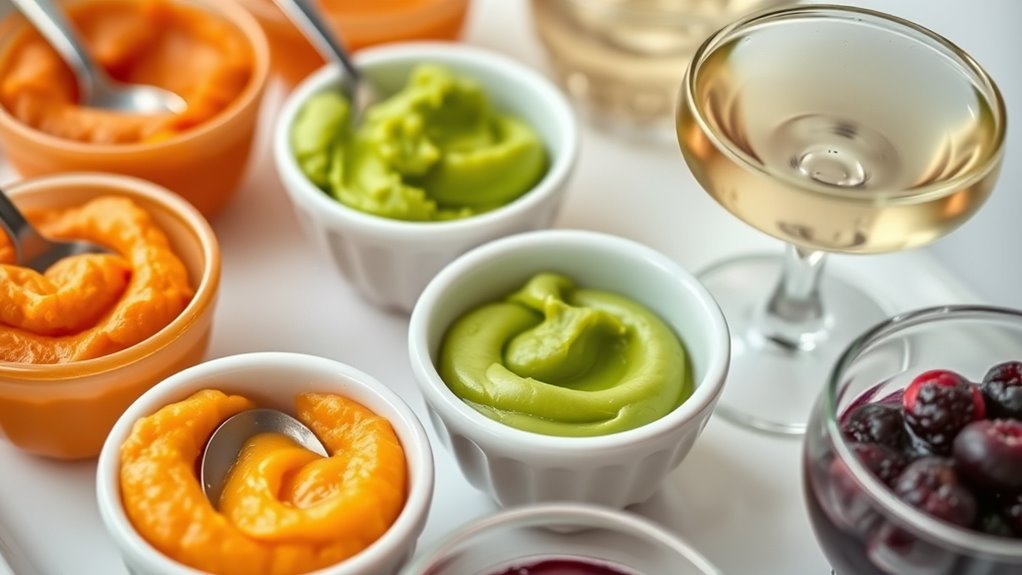Managing swallowing issues involves modifying foods and liquids to guarantee safety. You can use pureed foods like smoothies or mashed fruits, and thickened fluids such as nectar, honey, or pudding-thick textures to prevent choking and aspiration. Preparing these involves selecting fresh ingredients, adjusting textures with a blender or thickener, and serving in manageable portions. Paying attention to cues like coughing or throat clearing helps you make quick adjustments. For more detailed tips, you’ll find helpful strategies if you explore further.
Key Takeaways
- Modify food textures to pureed form and thickened liquids to reduce choking and aspiration risks.
- Use appropriate thickening levels (nectar, honey, pudding) based on individual swallowing severity.
- Ensure proper preparation, storage, and serving of purees and thickened fluids for safety and freshness.
- Monitor swallowing cues like coughing or throat clearing to adjust textures promptly.
- Conduct regular assessments and collaborate with healthcare providers to tailor texture modifications effectively.
Understanding Dysphagia and Its Impact

Dysphagia, or difficulty swallowing, can substantially affect your health and quality of life. It makes eating and drinking challenging, increasing your risk of choking, malnutrition, and dehydration. You might find it hard to enjoy meals or stick to your usual diet, which can lead to emotional stress and social withdrawal. Depending on the severity, swallowing issues can stem from neurological conditions, muscle problems, or structural abnormalities. Recognizing these signs early is essential to prevent complications. Specialized swallowing techniques and tools can help manage symptoms more effectively. The choice of appropriate food textures and consistency is also critical in ensuring safe swallowing and nutrition. Consistency modifications are vital tools in managing dysphagia, helping to reduce the risk of aspiration. Dysphagia also impacts your confidence during meals, as you may worry about choking or aspirating food into your lungs. Understanding how this condition affects you helps you and your healthcare team develop effective strategies to manage it and maintain your health and independence.
The Role of Pureed Foods in Safe Eating

Have you ever wondered how pureed foods can make eating safer for those with swallowing difficulties? Pureed foods reduce choking risks by eliminating textures that are hard to chew or swallow. They create a smooth, uniform consistency that’s easier to manage. This minimizes aspiration and ensures nutrients are ingested safely. To help you understand their benefits, consider this table:
| Benefit | How It Helps | Example Food |
|---|---|---|
| Improved safety | Prevents choking and aspiration | Pureed fruits |
| Easier swallowing | Reduces effort required to swallow | Mashed potatoes |
| Nutrient retention | Maintains essential nutrients | Blended vegetables |
| Increased compliance | Makes eating more enjoyable | Smooth yogurt |
Using pureed foods supports safe, comfortable eating for those with swallowing challenges.
Types and Uses of Thickened Fluids

Thickened fluids are essential tools for managing swallowing safety, as they help control the flow of liquids and reduce the risk of aspiration. There are different types, including nectar-thick, honey-thick, and pudding-thick, each serving specific needs. Nectar-thick liquids are slightly thicker than water, making them easier to swallow smoothly without rushing. Honey-thick fluids are even thicker, requiring more effort but providing added control for those with more severe swallowing issues. Pudding-thick fluids have a semi-solid consistency, ideal for individuals who struggle with liquid flow altogether. These variations are used depending on the person’s swallowing ability, ensuring safe intake while maintaining hydration and nutrition. Proper use of these thickened fluids can profoundly improve safety and comfort during meals.
Preparing and Consigning Puree and Thickened Options

When preparing puree and thickened options, choosing the right ingredients is essential to guarantee safety and nutrition. You’ll also want to pay attention to achieving the proper texture and consistency for easy swallowing. Additionally, incorporating appropriate flavoring options can improve palatability and encourage intake. Using fresh ingredients whenever possible can help prevent spoilage and ensure better flavor, which is especially important for identifying bad lemon juice. Finally, proper storage and clear labeling help maintain quality and prevent confusion.
Selecting Suitable Ingredients
What ingredients work best for creating safe and nutritious purees and thickened options? Fresh fruits and vegetables are excellent choices—they’re naturally nutritious and easy to blend. Use lean meats, cooked until tender, and then puréed for added protein. Dairy products like yogurt and milk can help achieve the desired consistency and boost nutrition. When selecting ingredients, avoid those with skins, seeds, or tough fibers that don’t blend smoothly. Opt for ingredients with a soft texture to ensure safety and ease of swallowing. Be cautious with high-sugar or high-fat items, as they can affect health. Always choose ingredients that are fresh, free of additives, and appropriate for the individual’s dietary needs. Proper ingredient selection is key to creating safe, tasty, and nutritious purees and thickened fluids.
Texture and Consistency Tips
Achieving the right texture and consistency is essential for making safe, swallowable purees and thickened liquids. To do this, start by gradually adjusting the thickness to match the person’s needs. Use a blender or food processor to create smooth, uniform textures, ensuring there are no lumps or chunks that could cause choking. When thickening liquids, add thickening agents slowly, stirring constantly to reach the desired consistency—whether nectar, honey, or pudding-like. Always test the texture by letting a small amount cool before serving. Keep in mind that consistency may need regular adjustments based on feedback and changes in swallowing ability. Clear, smooth textures help reduce the risk of aspiration and make swallowing safer and more comfortable.
Proper Storage and Labeling
Proper storage and labeling are critical to maintaining the safety and quality of pureed and thickened liquids. Always store these items in airtight containers to prevent contamination and spoilage. Keep them at the recommended temperature, usually in the refrigerator or freezer, depending on their type and shelf life. Label each container clearly with the contents, preparation date, and any special instructions, such as reheating guidelines. This helps you and others easily identify and use the right product, reducing the risk of errors. Avoid mixing leftovers from different days or recipes, as this can compromise safety. Regularly check stored items for signs of spoilage, such as off-odor or discoloration. Proper storage and labeling ensure you deliver safe, high-quality options for those with swallowing difficulties.
Tips for Ensuring Safety During Meals

Ensuring safety during meals is essential when managing swallowing issues, as it helps prevent choking and aspiration. Always sit upright at a 90-degree angle to make swallowing easier and reduce risk. Take small bites and encourage chewing thoroughly before swallowing. Use appropriate utensils and serve food in manageable, consistent textures like purees or thickened liquids. Stay attentive and avoid rushing, giving yourself time to swallow completely before taking the next bite. Keep your environment calm and free of distractions to focus on safe eating. If you experience discomfort or difficulty swallowing, stop eating and inform your caregiver immediately. Regularly check the temperature and consistency of your food to prevent surprises that could cause choking. These practices help make mealtime safer and more comfortable.
Monitoring and Adjusting Dietary Needs

To effectively manage swallowing issues, you need to regularly assess nutritional needs and recognize when cues indicate changes. Watching for signs that swallowing has become more difficult helps you decide when to modify consistency levels. Staying attentive ensures your loved one maintains proper nutrition and safety during meals. Incorporating mindful decluttering strategies by minimizing distractions can further improve the safety and effectiveness of meals. Additionally, understanding texture modification techniques can help tailor diets to individual needs and prevent aspiration risks. Incorporating safe, non-toxic materials in toys can also support development and reduce potential hazards during playtime.
Regular Nutritional Assessments
How often should you check on your nutritional status when managing swallowing issues? Regular assessments ensure your diet stays balanced and meets your changing needs. Ideally, schedule these evaluations every 1 to 3 months, or more frequently if your condition changes. During each check, focus on these key areas:
- Tracking weight and body measurements to spot weight loss or gain.
- Monitoring energy levels and overall well-being.
- Reviewing dietary intake and fluid consistency.
- Adjusting textures or nutrient composition based on improvements or challenges.
These assessments help you catch nutritional deficiencies early and make timely modifications. Staying proactive guarantees you maintain strength, hydration, and health while managing swallowing difficulties effectively.
Recognizing Swallowing Cues
Recognizing swallowing cues is essential for adjusting your diet to stay safe and comfortable. Pay close attention to signs like coughing, throat clearing, or a wet voice after swallowing. These cues indicate if you’re having trouble or need to modify your intake. Monitoring your responses helps prevent choking and ensures you’re getting enough nutrition.
Here’s a simple table to guide you:
| Cue | What It Means | Action Needed |
|---|---|---|
| Coughing during meals | Possible aspiration or difficulty | Slow down, try smaller bites |
| Throat clearing | Residue or irritation | Rinse mouth, adjust food consistency |
| Wet voice after swallowing | Food or liquid remaining in airway | Seek medical advice if persistent |
Stay attentive to these cues, and adjust your eating habits accordingly.
Adjusting Consistency Levels
Monitoring and adjusting the consistency of your food and liquids is essential for safe swallowing. When you notice difficulties or discomfort, it’s important to modify textures accordingly. Here are four steps to help you adjust effectively:
- Observe how your body responds to different consistencies during meals.
- Consult with your healthcare provider or dietitian for personalized recommendations.
- Experiment with slight texture changes, like thickening liquids or pureeing foods further.
- Record your experiences to identify which textures work best and when adjustments are needed.
Frequently Asked Questions
How Can I Tell if Someone Needs Puree or Thickened Fluids?
To figure out if someone needs puree or thickened fluids, watch for signs like coughing, choking, or difficulty swallowing. Consult a healthcare professional if they show these symptoms, as they can assess their swallowing ability. You might also notice weight loss or withdrawal from eating. Always follow medical advice to guarantee their safety, because proper texture modifications help prevent choking and aspiration.
Are There Specific Brands Recommended for Safe Thickened Liquids?
Think of thickened liquids as a carefully crafted recipe—your choices matter. You should look for brands like Thick-It or SimplyThick, which are trusted for their safety and consistency. Always check labels for appropriate thickness levels and consult with a healthcare professional to guarantee you’re selecting the right product for your needs. Remember, using recommended brands helps you navigate the waters of safe swallowing with confidence.
Can I Prepare Puree and Thickened Fluids at Home Safely?
Yes, you can prepare puree and thickened fluids at home safely. Use fresh, high-quality ingredients and follow trusted recipes designed for swallowing safety. Always measure thickening agents carefully to achieve the right consistency and avoid choking hazards. Test the texture before serving, and consult with a healthcare professional or speech-language pathologist for personalized guidance. Proper hygiene and storage are also essential to prevent foodborne illnesses.
How Do I Prevent Choking During Meals With Thickened Fluids?
Did you know that choking accounts for about 60% of accidental deaths in older adults? To prevent choking during meals with thickened fluids, sit upright and stay still while eating. Take small bites, chew thoroughly, and don’t rush. Make certain the thickened fluids are at the right consistency, and encourage slow, deliberate swallowing. Always supervise meals, and seek help if you or your loved one shows signs of difficulty.
What Are Alternative Options if a Person Dislikes Pureed Foods?
If you’re looking for alternatives because someone dislikes pureed foods, consider offering soft, moist foods like scrambled eggs, tender cooked vegetables, or finely chopped meats. You can also try foods that are naturally easy to swallow, such as yogurt, pudding, or smoothies. Adjust the texture by chopping or mashing, ensuring it’s manageable for swallowing. Always monitor for any difficulty and consult a healthcare professional for personalized advice.
Conclusion
By mastering the art of managing swallowing issues, you become the guiding light in safe eating. Think of pureed foods and thickened fluids as yourtrusted allies, transforming mealtime into a smooth, worry-free journey. With careful preparation and vigilant monitoring, you create a safe harbor where every bite and sip sails peacefully. Embrace these tools, and you’ll turn challenging waters into a calm, nourishing voyage, ensuring comfort and safety with every meal.









